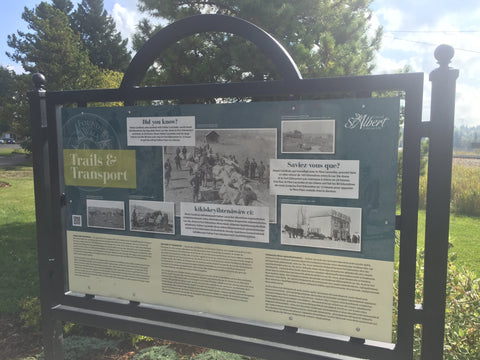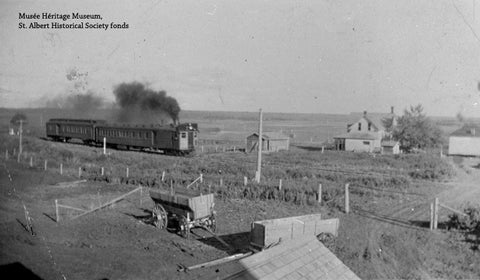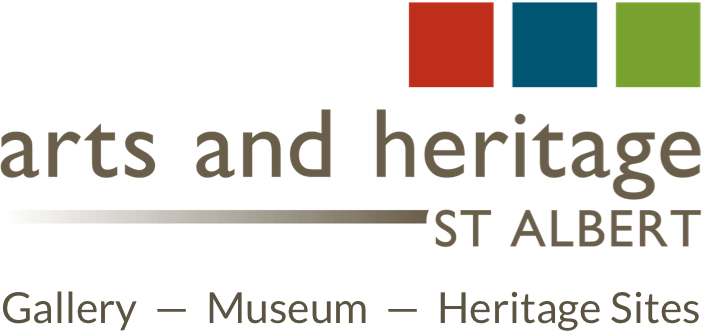

ONLINE EXHIBITION
16B. Trails and Transport
Trails and Transport
For generations the people of the First Nations have travelled along the Sturgeon River, their trails criss-crossing its 260 kilometre length. With the arrival of Europeans, the Lac St. Anne Trail became a major route from Fort Edmonton to the Mission at Lac Ste. Anne. There was an early river crossing at the west end of Big Lake. The trail then headed around the lake turning north along the river to trails heading west to Lac Ste. Anne, or north to the Pembina and Athabasca rivers. Thousands of kilograms of dried fish were hauled from Lac Ste. Anne to Fort Edmonton each year. While the trails through this region were crucial for the fur trade, the transportation and supply network was, most importantly, the lifeline for the First Nations, Métis and European settlers.
Canoes and boats were used on the Sturgeon River, however its winding course made overland travel more direct. First Nations people used a simple wooden hauling frame called a ‘travois’ to drag their belongings behind a horse or dog. The Hudson’s Bay Company also used horses as pack animals or to pull carts. They kept horses near Big Lake for use on trading expeditions. Oxen were often chosen to pull ‘Red River carts’, perhaps the most common vehicle for hauling goods. Made entirely of wood, they were easily repaired and each cart could carry up to 550 kilograms of goods. Dog sleds were a practical choice for transportation in the winter. Partially enclosed sleds called ‘carioles’ could carry passengers as well as goods. For larger loads, horse sleds were used.
Sentiers et Transport
Depuis des générations, les Premières Nations, ont voyagé le long de la rivière Esturgeon sur des sentiers sillonnant sur 260 kilomètres. Avec l’arrivée des Européens, le sentier du Lac Ste-Anne entre le Fort Edmonton et la Mission du Lac Ste-Anne est devenue une route majeure. Autrefois, une rivière traversait l’ouest de Big Lake. Le sentier suivait le tour du lac virant vers le nord pour ensuite longer la rivière en direction de l’ouest jusqu’au lac Ste-Anne ou vers le nord jusqu’aux rivières Pembina et Athabasca. Chaque année, des milliers de kilogrammes de poissons séchés étaient transportés du Lac Ste-Anne jusqu’au Fort Edmonton. Les pistes traversant la région étaient essentielles au commerce des fourrures, pour le transport et les réseaux de distribution, mais surtout elles étaient primordiales à la survie des gens des Premières Nations, des Métisses et des colons européens.
Les voyages par voie terrestre étaient plus directs que ceux par canoë ou par bateau sur la rivière ondulante de l’Esturgeon. Les gens des Premières Nations utilisaient des travois tirés par un cheval ou un chien pour emporter leurs effets personnels. La Compagnie de la Baie d’Hudson utilisait aussi des chevaux pour tirer leurs chariots. Elle gardait ses chevaux près de Big Lake pour des expéditions de commerce. Les charrettes de la Rivière-Rouge, tirées par des boeufs, étaient le moyen de transport le plus utilisé pour transporter des marchandises. Elles étaient faites de bois et elles étaient faciles à réparer. Chaque charrette pouvait transporter jusqu’à 550 kilogrammes de biens. L’hiver, les traineaux à chiens étaient un moyen de transport pratique. Des carrioles pouvaient transporter des passagers ainsi que des marchandises. Des traineaux à chevaux étaient utilisés pour les grandes charges.
âniskac iyiniwak ohci iyinînahk kîpimâcihowak namêw sîpîhk, mêskanâsa kâh-kwêkwask itamona pêyak kihcimitâtahtomitanaw mîna nikotwâsosâp mistikwa isko. Ispî kâhtakohtêcik pîtâtowêwak, anita Lac. Ste. Anne mêskanâs kîhâpacihtâniwiw Fort Edmonton ohci isko ayamihêwînînâhk anita Lac. Ste. Anne. êkîhayâk nistam êkota sîpiy âsowahonân pahkismôtâhk ohci mistahi sâkahikanihk. mêskanâs êkwa êwako kïpimitamon wâsakâm sâkahikanihk êpimiwâkamosihk isi kîwêtinohk sisonê sîpiy ita mêskanâsa êpimitamohki pâhkisimohtâhk isi Lac Ste. Anne, ahpô kîwêtinohk isi Pembina êkwa kapâwin sîpiya. kihcimitâtahtomitanaw êkosikwâki namêstêkwak êkîhawahihcik Lac Ste. Anne isi Fort Edmonton tahtwâskiy. âta iyikohk êkîhâpatahki ôhi mêskanawa ohci wayân mêskotônikêwin, opimpahiwêwin êkwa atâwêwina kâpâmatâwâkêhk mêtoni, kîhâpacihcikâtêw, opimâtisowiniwâw ohci iyiniwak, otipêyimisowak, êkwa pîtâtowêwak.
cîmâna êkwa ôsah êkîhâpatisicik anita namêw sîpihk, tânâsipoko êhisiwâwâkamok nawâc kîwehcasin kamoscipimohtahok. iyiniwak kîhâpacihtâwak akotascikan êhisiyihkâtêk ‘akotâpân’ kapimitâpêcik otipeyawehoniwâwa êhâpacihâcik mistatimwa ahpô atimwa. Hudson’s Bay Company mîna âpacihêwak mistatimwa kapimtapêyit ahpô kapimitâpêyit nêwokâtêwa. kîkanawêyimêwak mistatimwa cîki mistahi sâkahikanihk ita kamêskotônikêcik. ayihkwêw mostoswa êkîhapacihihcik kahotâpêcik ‘Red River cart’ êwako mâna ehâpatisit kahâwacikêhk. mihta ohci êhosihiht, kîwêhcasin kanânapâcihihcik êkwa kîkaskihowak kahawacikêcik isko nîyânomitanaw kihcimitâtahomitanaw ekisikwâki atâwêwinisa. atimotâpânâsk êkîhâpatisit kâpipohk. êkwa âpihtaw isko êkwa yakwahamot otâpânâsk êhisiyihkâsot “carioles’ kîpôsiwak mîna êkota ayisiyiniwak asci. ayiwâk kâkisikwâki kîkwaya kîhâpatisiwak mistatim otâpânâskwak.



